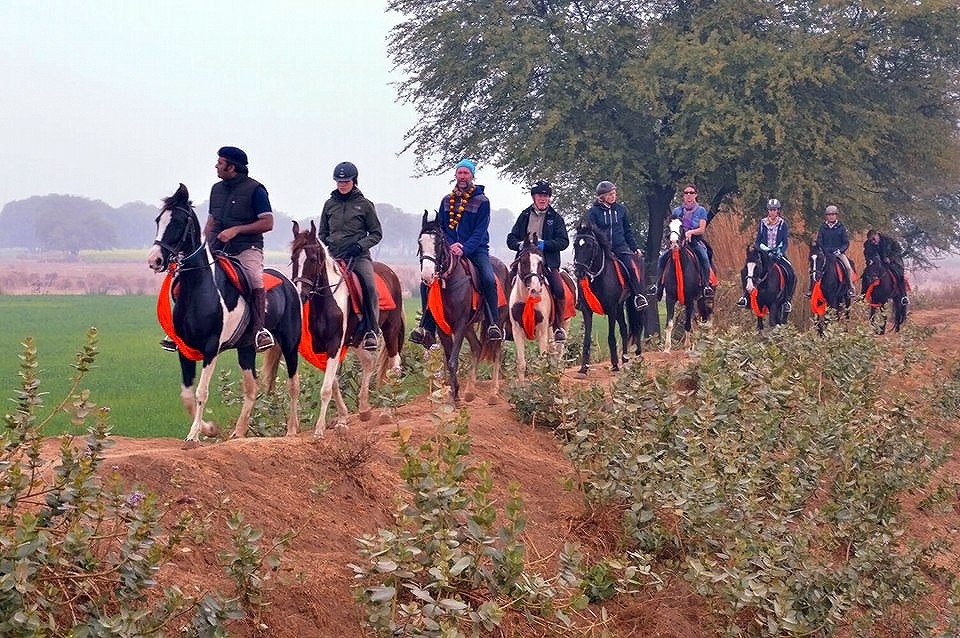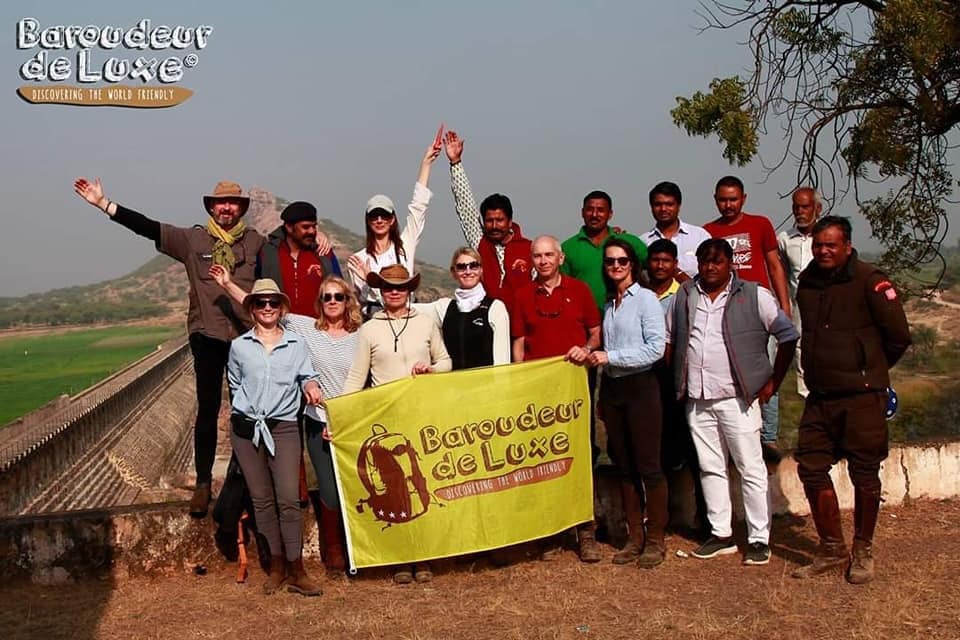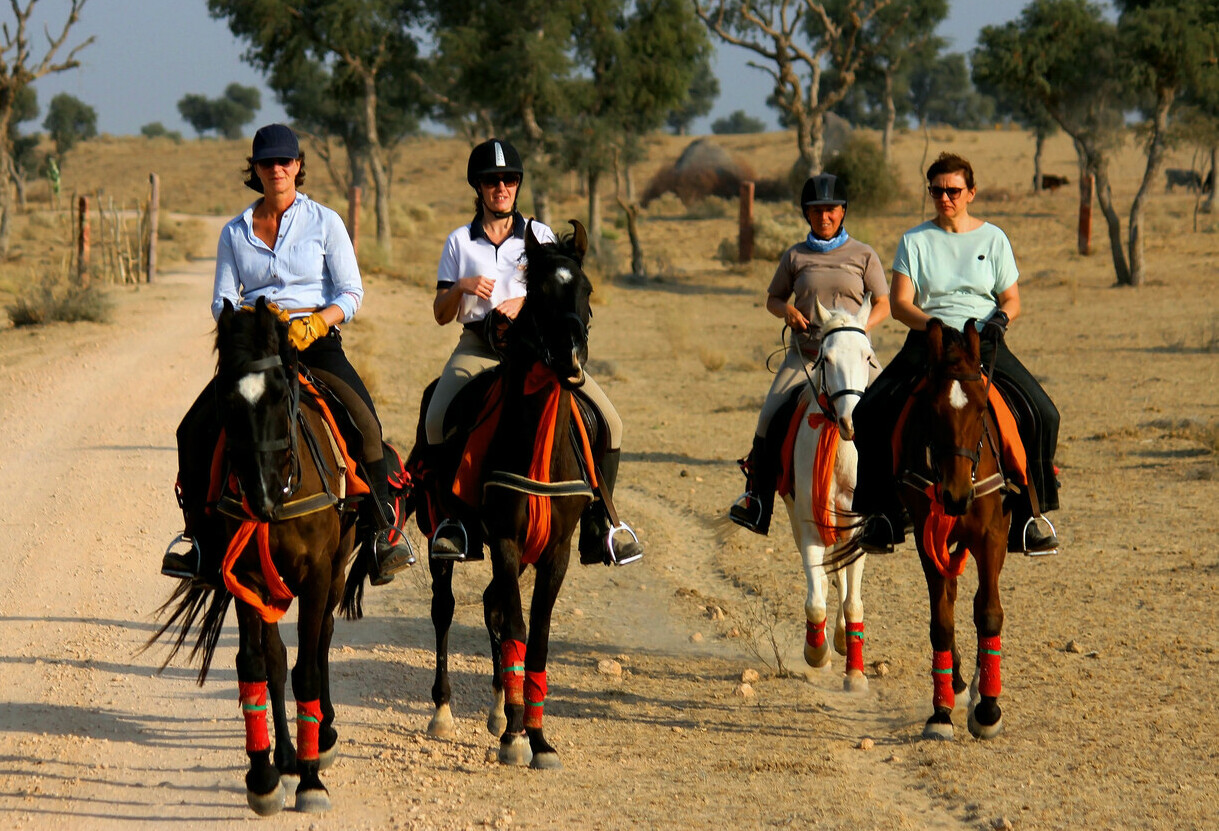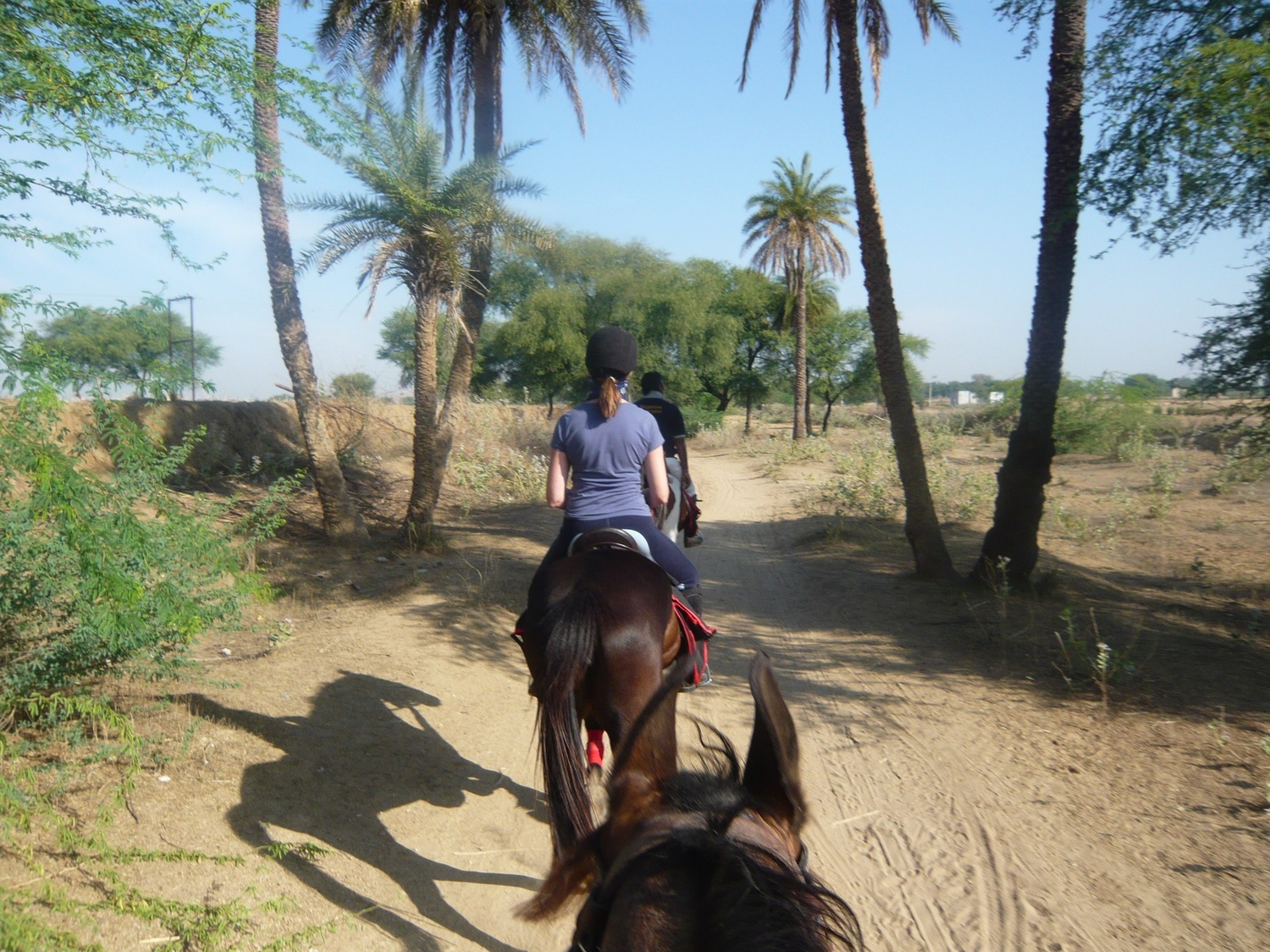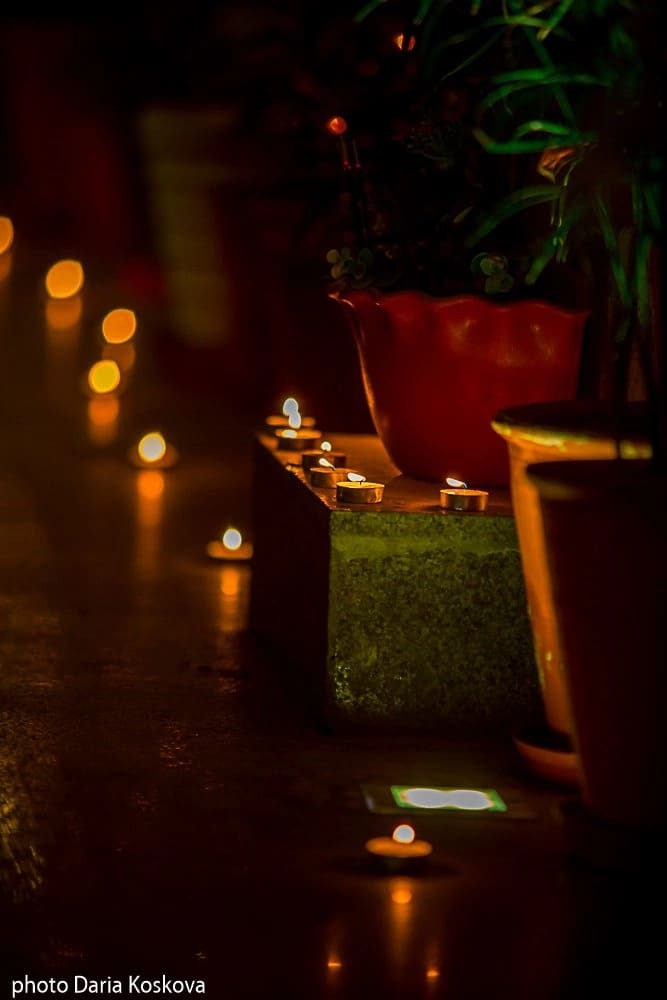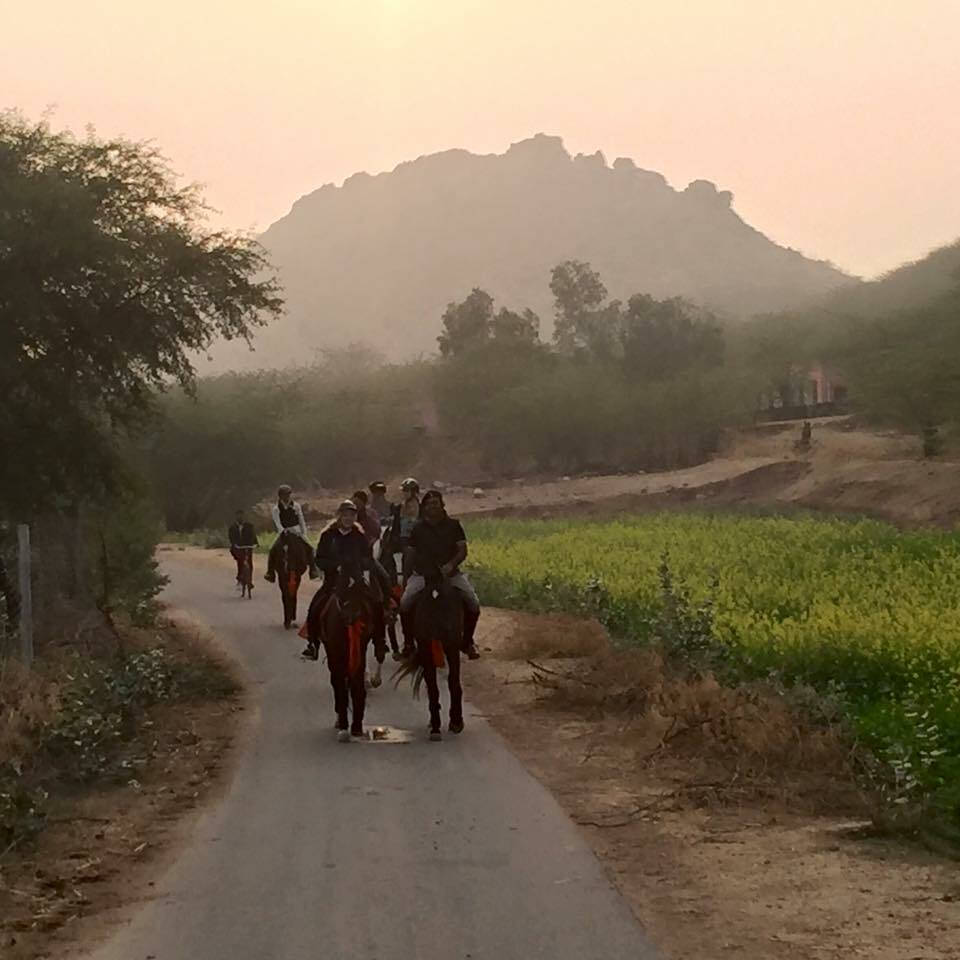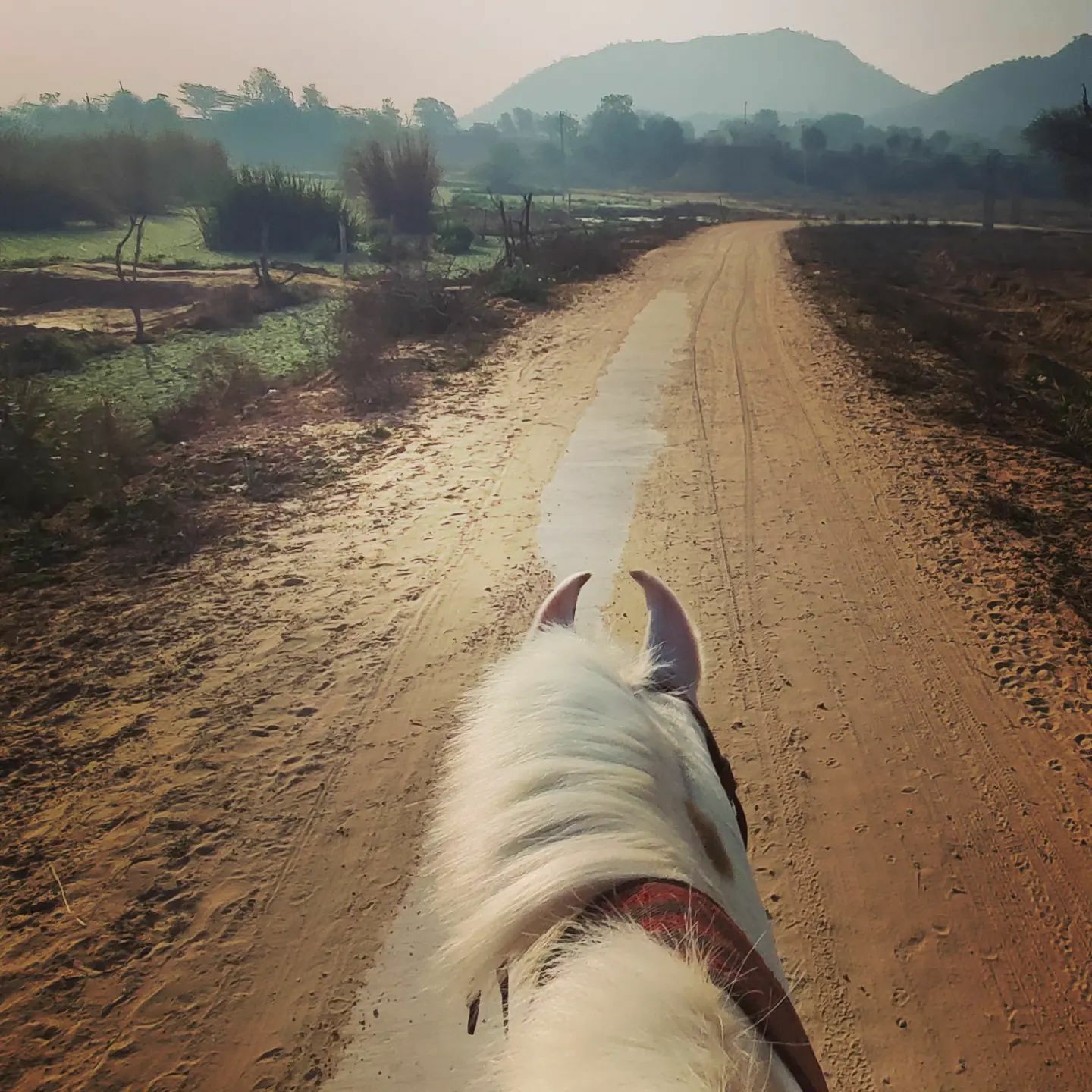| Телефон | +1(23)-45-67-890 |
| support@ukit.com |
Offered Trail rides
India is fascinating country. With its diverse landscapes and rich cultural heritage, India offers some of the most enchanting horse-riding destinations, and Rajasthan is the perfect place to combine riding on Marwari horses with some sightseeing included.
Ride through villages and meet the locals. canter along sandi tracks or cross vast areas of sand dunes.
Enjoy impressive riding vacations. It's an experience you will never forget!
We'd love to welcome and accompany you.
Common information for all offered rides
Have you ever tried to travel on horseback? That’s an unique experience - you can’t get in closer contact with the people, their animals and the characteristic landscape.
Our trail rides normally lasts the whole day and we cover distances up to 35 km a day. After hours in the saddle horses and riders appreciate a long lunch brake. We always try to find a nice and quiet place for it. While the horses eat and rest, we have lunch, relax and if you like you can have a little nap - everything is prepared for you.
At our trail rides we stay in hotels and local havelis, but also a few nights in the desert. The tents in the camp are luxurious with comfortable beds and its own bathrooms which include showers and hot and cold running water. At the dinner you enjoy music and dance from local musicians. It’s a special and unique atmosphere and the nature is overwhelming.
- all our rides are guided in English language
- all our rides are accompanied all the way long by Jeeps
- Jeeps can be used for non-riders who want to join our tours
- accomodation at Heritage hotels, typical Indian Havelis, tents (combined all types of accomodation or without tents - see the info about exact tour below)
- our guests stay in rooms for 2 persons, single room can be arranged by your request so please contsct us about it before order tour
- included: accomodation, transportation on the tour, all meals, bottled water, sightseeing
- not included: flights, visa, drinks, tips
Desert & Horses
Day 1
Arrival in Delhi to be met by a Riding in India representative. Drive to Ramgarh Shekawati (5.5 hours )
Lunch on the way.
Overnight stay in Ramgarh Fresco Hotel. Tea/coffee and relax.
Dinner.
Ramgarh Fresco, a beautifully restored old haveli (mansion) with lovely frescoes. It is ideally located to explore the entire Shekhawati region. Ramgarh Fresco, formerly known as the Khemka Haveli, was bought and converted into a boutique hotel in 2009 by the Khandelwal family of Delhi. It is now operated by Raghvendra & Priya Rathore, who are from a prominent Rajasthani family.
The hotel has 14 rooms, ranging from a cosy single room for individual privacy to large suites. The rooms are spread interestingly across the property. Each room has an en suite bathroom with hot and cold running water. The suites are air conditioned.
The décor is simple and tasteful - everything from the elegantly hand crafted wooden furniture to lampshades to the colourful bedspreads to carefully selected art objects, enhances the vibrant paintings that cover the haveli. The hotel specialises in homestyle Rajasthani cooking, for which it is well known.
Day 2
Casual ride around Ramagarh, come back to the hotel, have lunch in the hotel and relax. In the evening visit the town and have dinner at the roof top.
Day 3
Breakfast, followed by full day ride from Ramgarh to Ratangarh starting in the morning; ride distance is about 35 kms.
The ride on this day takes you across several farms and huge sand dunes where you might see the Chinkara Gazelle. Lunch stop for 2-3 hours in the farmland. Dinner and overnight in a hotel at Ratangarh
Day 4
Breakfast, followed by full day ride from Ratangarh to Taalchaper starting in the morning; ride distance is about 35 kms.
This morning sees another change in topography: we leave the arid, sandy country and enter a flat area where the soil is richer and plant life more vigorous. This is the Taal Chappar black buck sanctuary.
„Taal” means „plain” and Chappar is the name of the adjacent village. The land is flat and used to be a floodplain, but the lowering of the water-table combined with a thriving salt mine, not far from the boundary, means that little water now reaches the sanctuary. The birds, animals and plants that thrive here are desert specialists. The blackbuck is probably the most famous resident and look smart in their contrasting black and white livery: top half black, lower half white. They are about the size of our roe deer, or Springbok if you’ve visited southern Africa.
Lunch stop for 2-3 hours in the farmland. Dinner and overnight in a hotel at Taalchaper.
Day 5
Breakfast, followed by full day ride from Taalchaper to Raid starting in the morning; ride distance is about 35 kms.
The topography and landscape changes too. The country becomes drier and there’s an abrupt appearance of sand dunes – some are quite large. The horses need to work hard to travel through the softer, deeper sand and there are some sharp.
Lunch stop for 2-3 hours in the farmland. Dinner and overnight in our camp.
Day 6
Breakfast, followed by full day ride from Raid to Raiser starting in the morning; ride distance is about 35 kms.
You can witness village houses, herds of cattles, colorful dresses, the lifestyle of villagers living without basic amenities of urban culture. On your route to the camp, you enjoy fauna and flora of desert in its fullest. As you reach the camp, camel carts give you a round of the desert. And at the end of the day, you are free to take an evening stroll and absorb the total tranquility of the bush at dusk. The camp has all amenities and we provide you a gala dinner with folklore, music and dance besides camp fire. When your adventure is over, the memories of this outstanding experience will remain with you for many years.
Lunch stop for 2-3 hours in the farmland. Dinner and stay overnight in our camp.
Day 7
Breakfast, followed by full day ride from Raisar to Deshnok in the Thar Desert, starting in the morning; ride distance is about 35 kms.
Trees and grass are sparse. In some places the wind and shifting sands have created spectacular sand dunes which tower above the plain. Despite the austerity of the land a surprising number of people manage to eek out a living here. Enroute you pass several small villages.
Lunch stop for 2-3 hours in the farmland.
Optional visit to the Rat Temple in Deshnok.
Deshnok is a small town in the Bikaner district of Rajasthan, India, near the Pakistan border and about 30 km from Bikaner. Deshnok is famous for its 600-year-old Karni Mata Temple, where rats are worshipped.
Dinner and stay overnight in our camp.
Day 8
Breakfast, followed by full day ride from Deshnok to Bikaner starting in the morning; ride distance is about 35 kms.
We are passing through a couple of small villages and several farmlands and large sand dunes. On this day there are also good possibilities of seeing the elusive desert fox.
Lunch stop for 2-3 hours in the farmland. Dinner and stay overnight in Lalgarh Palace or Gangan Mahal Palace.
One of the most popular heritage hotels in Bikaner, Lalgarh Palace is known for the most intricate stone carving on red stone and its grand Indo-Saracenic architecture. Spread in verdant gardens with dancing peacocks, open courtyards and vibrant bougainvillea flowers, this heritage hotel offers its guests a memorable stay. Built in the end of the 19th century, the hotel has huge, well-fitted guest rooms and suites. While the decor is regal, the services are world-class. At the on-site multi-cuisine restaurant, the guests can savour sumptuous meals.
Day 9
Breakfast and then drive to Bikaner for sightseeing at the Fort. After visiting we drive to Jaipur with lunch on the way. Stay overnight in Jaipur with dinner.
Day 10
Breakfast and full day sightseeing in Jaipur.
The rose-pink capital of Rajasthan is surrounded on all sides by rugged hills, crowned with forts. Enclosed by embattled walls, the city was built early in the eighteenth century. The Maharaja's palace stands in the centre of the city amidst lovely gardens. Houses with latticed windows line the streets, their rose-pink colour lending enchantment to the scene and almost magical at sunset. Jaipur is aptly called the "Pink City of India". It takes its name from the famous Maharana Sawai Jai Singh, who founded the city in 1728. A keen astronomer, he built an observatory, which still exists and is equipped with quaint masonry instruments of remarkable size.
Jaipur is noted for its craftsmen skilled in the art of cutting precious stones and famed for its garnets and rubies. It is equally well known for brass inlay work, lacquer work and the printings of muslin.
Places to see in Jaipur: The City Palace which now houses a museum containing rare manuscripts, painting and an armoury; the Jantar Mantar observatory - built in the 17th century by Jai Singh - with a sundial 90ft.high (now a UNESCO World Heritage Site); the Museum amidst the Ram Niwas Palace Gardens founded in 1876 with a large collection of antiques; the palace of Winds, a landmark of Jaipur made of pink sandstone and of unique design.
Lunch. Dinner at a local restaurant. Stay overnight in Jaipur.
Day 11
Breakfast followed by market visit and lunch.
In the evening we visit our Polo Club where guests can try Stick N Ball (polo lesson)
The origin of ancient Polo is debatable with several countries, including Persia and China, laying claim to this aristocratic game of prowess and skilled horsemanship.
Known by several local names in different countries – Chaughan (Persian), Da-Kyu (Japanese), Khis-Kouhou (Russian), Djerid (Turkish), and Sagol Kangjei (Indian), the origin of Polo modern name is perhaps most closely akin to its Tibetan variation, Pulu, which means ball.
In India, Polo or the game of kings was popularized under the rule of Babar, founder of the Mughal dynasty in the 15th century among the royalty. With the rise of the Mughal dynasty, Polo gained its regal status and was firmly established as the national sport of India, and sadly with the eventual decline of the dynasty in the 18th century, the sport too lost its place in the hearts of many. Fortunately, in the remote regions of Gilgit, Ladakh and Manipur, the sport survived and it was in Manipur, many decades later that the sport was rediscovered once more and gained popularity among the Westerners.
The origination of ancient Polo may be controversial; yet its spread to the west is undoubtedly credited to India around 1860 when a British officer, together with seven British Tea Planters based in Silchar, set up the first club of the modern game, the Silchar Polo Club. From then on, the popularity of the sport caught on among the British subjects in India and eventually the sport was introduced to Europe. Once imported to Europe, Polo soon became a fashionable sport, especially among the nobilities and in the army.
Dinner at the Polo Club. Stay overnight in Jaipur.
Day 12
Breakfast and drive to Delhi for departure.
DESTINATIONS: Delhi / Ramgarh Shekhawati/Gajner/Siyana/Deshnok/Raiser (Bikaner)/Jaipur/Agra (optional)/ Delhi.
DURATION : 10 Nights / 11 Days.
LENGTH OF RIDE : 35 to 40 KM in a day around 6 & 7 Hours a day on Average
ON HORSE BACK : 06/07 days
SIZE OF GROUP : Minimum 4 & Maximum 18 Riders
NON RIDERS: possible
DATES: according to your request if you have minimum 4 people to come
PRICE: 2100 Euro
EXTRA: flight, visa, drinks, tips
Castles & Tigers
Our journey starts in Delhi, from where we travel to Agra.
Day 1
Arrive in Delhi where you will be met by our Riding in India staff. Drive to Agra (260Kms, 5 hours approx)
Dinner and overnight stay in Hotel , 3/4 star. Hotel to be determined at later date.
Day 2
Early morning visit to Taj Mahal and return to Hotel for breakfast.
The Taj Mahal (a UNESCO World Heritage site) is one of the seven wonders of the world. It was built by the Mughal Emperor Shah Jehan in memory of his beloved consort Mumtaz Mahal. This beautiful musoleum is pure white marble and an architectural marvel. Built in 1631-48 in Agra, seat of the Mughal Empire, the monument sums up many of the formal themes that have played through Islamic architecture. Its refined elegance is a conspicuous contrast both to the Hindu architecture of pre-Islamic India, with its thick walls, corbelled arches, and heavy lintels, and to the Indo-Islamic styles, in which Hindu elements are combined with an eclectic assortment of motifs from Persian and Turkish sources.
After breakfast check out and visit Agra Fort.
The Agra Fort ( a UNESCO World Heritage site) is one of the most important and robustly built stronghold of the Mughals, embellished with number of richly decorated buildings encompassing the imposing Mughal style of art and architecture. It was constructed by the third Mughal emperor Akbar on the remains of an ancient site known as Badalgarh between 1565 and 1573. He ordered to renovate the fort with red sandstone and some 4000 builders daily worked on it and it was completed in 8 years (1565-1573).
This powerful fortress of red sandstone, semi-circular on plan, is surrounded by a 2.5 kms. long and 21.4 m high fortification wall. Double ramparts have been provided here with broad massive circular bastions at regular intervals. There are four gates on its four sides, one of the gates was called “Khizri-gate” (the water gate) which opens to the river front, where ghats (quays) were provided. The fort has survived through the onslaught of time, nature and men. Spreading over an area of about 94 acres of land, it comprises many fairy-tale palaces, such as the Jehangir Palace and the Khas Mahal, built by Shah Jehan (the builder of Taj Mahal ), audience halls, such as the Diwan-i-Khas; and two very beautiful mosques.
Lunch on the way to Ranthambore (270kms), Arrive at Juna Mahal a luxury boutique Hotel with views to the Araval Hills of Ranthambore. Meet the horses.
Dinner.
Hotel Juna Mahal - Best luxury hotels in Ranthambore
Experience luxury and royalty at one of the best luxury hotels in Ranthambore / luxury resorts in Ranthambore, Sawai Madhopur, Rajasthan, India which offers a spectacular view of nature, a rare combination of heritage and modern architecture.
Day 3
OPTIONAL early morning visit by jeep to Ranthambore tiger park.
Ranthambore National Park is in Sawai Madhopur District of Rajasthan state. Located at the junction of the Aravalli and Vindhya hill range, this is one of the finest places to view animals, especially as they are used to being stared at here. The park covers an area of Approximately 400 sq Km and if combined it with the area of sawai man singh sanctuary area, it is around 500 Sq km. The sanctuary is a wildlife enthusiasts and photographers dream.
Breakfast on return from park. Time to relax by the luxurious pool followed by lunch at the Hotel.
Late afternoon short casual ride close to the Hotel to get to know your horse.
Dinner.
Day 4
Early Breakfast and by 9am leave the Hotel to ride to Nahri (30kms). Nahri is a small village where we stay in tented accommodation.
Our team set up a lunchtime camp where we can enjoy delicious food and rider and horses can rest for 2-3 hours.
Dinner at camp with local folk music entertainment.
Day 5
Breakfast in camp and ride form Nahri to Harsota (25kms) crossing a wide river bed, where we’ll see a variety of wildlife including antelope.
Lunch stop for 2-3 hours on the ride.
Arrive in Harsota where our tents are pitched in the grounds of the village chief’s home.
Dinner is served on the terrace. Meet villagers and enjoy local musical entertainment.
Day 6
Early breakfast.
Visit the local school and distribute books and pencils on behalf of Riding in India.
Full day ride from Hirsota to Bapoi (30kms)
We pass through villages where people come to greet us and see the farm workers in the fields. The terrain is soft and sandy and perfect for horses , with some long canters possible.
Lunch stop at Pakhala Dam, an old water reserve which is now often dry but with some water which attracts birdlife. Walk along the Dam wall or relax for 2-3 hours.
Bapoi is a small village and we stay in the Village Head’s Fort. The accommodation is basic but comfortable with en-suite bathrooms and we can enjoy dinner on the roof terrace.
Day 7
Breakfast and ride to Castle Talabgaon (25kms). The terrain varies, in some parts we will ride through villages and cross a dry river bed, open farmland and sandy tracks.
Talabgaon Castle was built in 1818 in the Rapjput style of architecture. Rajput Rulers had a keen sense of beauty in Art and Architecture which is seen in the artistic excellence of their temples, forts and palaces. Heritage luxury in the palm of nature.
Lunch will be in a shady camp area where you can relax for a few hours and interact with the villagers.
Arrive at the Castle Talabgaon late afternoon . Relax and enjoy the surroundings and in the evening Dinner with the Chieftain of the village.
Day 8
Breakfast and full day safari from Castle Talabgaon, stopping for lunch at the Mud House, a deserted farm. Rest for 2-3 hours, then return to Castle Talabgaon via the river bed and farmlands.
Dinner with local folk dancers and music by the pool.
Day 9
Breakfast and drive to Jaipur (100kms). Lunch in Jaipur and in afternoon sightseeing.
The rose-pink capital of Rajasthan is surrounded on all sides by rugged hills, crowned with forts. Enclosed by embattled walls, the city was built early in the eighteenth century. The Maharaja's palace stands in the centre of the city amidst lovely gardens. Houses with latticed windows line the streets, their rose-pink colour lending enchantment to the scene and almost magical at sunset. Jaipur is aptly called the "Pink City of India". It takes its name from the famous Maharana Sawai Jai Singh, who founded the city in 1728. A keen astronomer, he built an observatory, which still exists and is equipped with quaint masonry instruments of remarkable size.
Jaipur is noted for its craftsmen skilled in the art of cutting precious stones and famed for its garnets and rubies. It is equally well known for brass inlay work, lacquer work and the printings of muslin.
Places to see in Jaipur: The City Palace which now houses a museum containing rare manuscripts, painting and an armoury; the Jantar Mantar observatory - built in the 17th century by Jai Singh - with a sundial 90ft.high (now a UNESCO World Heritage Site); the Museum amidst the Ram Niwas Palace Gardens founded in 1876 with a large collection of antiques; the palace of Winds, a landmark of Jaipur made of pink sandstone and of unique design.
Lunch. Dinner at a local restaurant.
Day 10
Breakfast followed by half day sightseeing in Jaipur.
Lunch in local restaurant.
In the evening we visit our Polo Club where guests can try Stick N Ball (polo lesson)
The origin of ancient Polo is debatable with several countries, including Persia and China, laying claim to this aristocratic game of prowess and skilled horsemanship.
Known by several local names in different countries – Chaughan (Persian), Da-Kyu (Japanese), Khis-Kouhou (Russian), Djerid (Turkish), and Sagol Kangjei (Indian), the origin of Polo modern name is perhaps most closely akin to its Tibetan variation, Pulu, which means ball.
In India, Polo or the game of kings was popularized under the rule of Babar, founder of the Mughal dynasty in the 15th century among the royalty. With the rise of the Mughal dynasty, Polo gained its regal status and was firmly established as the national sport of India, and sadly with the eventual decline of the dynasty in the 18th century, the sport too lost its place in the hearts of many. Fortunately, in the remote regions of Gilgit, Ladakh and Manipur, the sport survived and it was in Manipur, many decades later that the sport was rediscovered once more and gained popularity among the Westerners.
The origination of ancient Polo may be controversial; yet its spread to the west is undoubtedly credited to India around 1860 when a British officer, together with seven British Tea Planters based in Silchar, set up the first club of the modern game, the Silchar Polo Club. From then on, the popularity of the sport caught on among the British subjects in India and eventually the sport was introduced to Europe.Once imported to Europe, Polo soon became a fashionable sport, especially among the nobilities and in the army.
Dinner at the Polo Club.
Day 11
Breakfast and drive to Delhi for departure.
DURATION : 10Nights / 11 Days
LENGTH OF RIDE : 35 to 40 KM in a day around 6-7 Hours a day on Average.
ON HORSE BACK: 06/07 days
SIZE OF GROUP : Minimum 4 & Maximum 18 Riders
NON RIDERS: possible
DATES: according to your request if you have minimum 4 people to come
PRICE: 2100 Euro
EXTRA: flight, visa, drinks, tips
Desert and Temples
Day 1
Arrival in Delhi to be met by a Riding in India representative. Drive to Ramgarh Shekawati (5.5 hours)
Lunch on the way.
Overnight stay in Ramgarh Fresco Hotel. Tea/coffee and relax.
Dinner.
Ramgarh Fresco, a beautifully restored old haveli (mansion) with lovely frescoes. It is ideally located to explore the entire Shekhawati region. Ramgarh Fresco, formerly known as the Khemka Haveli, was bought and converted into a boutique hotel in 2009 by the Khandelwal family of Delhi. It is now operated by Raghvendra & Priya Rathore, who are from a prominent Rajasthani family.
The hotel has 14 rooms, ranging from a cosy single room for individual privacy to large suites. The rooms are spread interestingly across the property. Each room has an en suite bathroom with hot and cold running water. The suites are air conditioned.
The décor is simple and tasteful - everything from the elegantly hand crafted wooden furniture to lampshades to the colourful bedspreads to carefully selected art objects, enhances the vibrant paintings that cover the haveli. The hotel specialises in homestyle Rajasthani cooking, for which it is well known.
Day 2
Breakfast and drive to Raisar camp. Lunch at the camp.
Raisar Camp is an innovative adventure in boundless ocean of velvety sand of Rajasthan. Discover majestically either on camel or on camel cart. It is a perfect setup between sand dunes in Raisar village, near Bikaner. You will find us eagerly waiting to give you a wonderful journey through the desert.
You reach the camp from the hotel through the sandy tracks, enroute untamed countryside, visiting one of the remotest village. You can´t turn your eyes away from spectacles of distant sand dunes shining brightly in the sun light. You will see occasional passer by's with turbans bigger than their head, meticulously plaited. There is a varied store of wildlife in this area; Antelope, Fox, Jackal, Rabbit, Blue Bull, Desert Cat, Chameleon, Monitor Lizard, Mongoose, Hedgehog, Squirrel etc.
You can witness village houses, herds of cattles, colorful dresses, the lifestyle of villagers living without basic amenities of urban culture. On your route to the camp, you enjoy fauna and flora of desert in its fullest. As you reach the camp, camel carts give you a round of the desert. And at the end of the day, you are free to take an evening stroll and absorb the total tranquility of the bush at dusk. The camp has all amenities and we provide you a gala dinner with folklore, music and dance besides camp fire. When your adventure is over, the memories of this outstanding experience will remain with you for many years.
We meet the horses and enjoy a short casual ride around the farmland.
Dinner in our camp.
Day 3
Breakfast, followed by full day riding around the area.
Lunch stop for 2-3 hours in the sand dunes and return to the camp.
Dinner with cultural programme.
Day 4
Breakfast, followed by full day ride from Raisar to Deshnok in the Thar Desert, starting in the morning; ride distance is about 35 kms.
Trees and grass are sparse. In some places the wind and shifting sands have created spectacular sand dunes which tower above the plain. Despite the austerity of the land a surprising number of people manage to eek out a living here. Enroute you pass several small villages.
Lunch stop for 2-3 hours in the farmland.
Optional visit to the Rat Temple in Deshnok.
Deshnok is a small town in the Bikaner district of Rajasthan, India, near the Pakistan border and about 30 km from Bikaner. Deshnok is famous for its 600-year-old Karni Mata Temple, where rats are worshipped.
Dinner and stay overnight in our camp.
Day 5
Breakfast followed by full day ride from Deshnok to Saina, starting in the morning; ride distance is about 35 kms.
The ride on this day takes you across several farms and huge sand dunes where you might see the Chinkara Gazelle.
Lunch stop for 2-3 hours.
Overnight stay and Dinner in Saina in Saina Hotel.
Day 6
Breakfast, followed by full day ride from Saina to Gajner.
Lunch stop for 2-3 hours.
Overnight stay and Dinner in Gajner Palace Hotel.
Gajner Palace is an incomparable "Jewel in the Thar Desert" built on the embankment of a lake by His Late Highness Maharaja Ganga Singhji of Bikaner. During winter the palace, with its beautiful lake and surrounded wooded areas, becomes the home of different species of migratory birds, most renowned amongst them being the Imperial Sand Grouse. Endangered antelopes like Black Bucks, Nilgais, Chinkaras and other animals like the Wild Boar roam freely in this area which is now a preserved sanctuary.
Gajner Palace is a beautiful heritage property made of Red Sandstone. One can appreciate the craftsmanship of the intricate carvings on red sandstone and experience the true romance of the desert in the comfort of Gajner Palace.
Day 7
Breakfast, followed by full day ride from Gajner to Bikaner.
While riding through this area you may see the Chinkara gazelle and if lucky, you might also come across the Desert Fox.
Lunch stop 2-3 hours
Overnight stay and Dinner in Lalgarh Palace or Gangan Mahal Palace.
One of the most popular heritage hotels in Bikaner, Lalgarh Palace is known for the most intricate stone carving on red stone and its grand Indo-Saracenic architecture. Spread in verdant gardens with dancing peacocks, open courtyards and vibrant bougainvillea flowers, this heritage hotel offers its guests a memorable stay. Built in the end of the 19th century, the hotel has huge, well-fitted guest rooms and suites. While the decor is regal, the services are world-class. At the on-site multi-cuisine restaurant, the guests can savour sumptuous meals.
Day 8
Breakfast and then drive to Bikaner for sightseeing at the Fort. After visiting we drive to Jaipur with lunch on the way. Stay overnight in Jaipur with dinner.
Day 9
Breakfast and full day sightseeing in Jaipur.
The rose-pink capital of Rajasthan is surrounded on all sides by rugged hills, crowned with forts. Enclosed by embattled walls, the city was built early in the eighteenth century. The Maharaja's palace stands in the centre of the city amidst lovely gardens. Houses with latticed windows line the streets, their rose-pink colour lending enchantment to the scene and almost magical at sunset. Jaipur is aptly called the "Pink City of India". It takes its name from the famous Maharana Sawai Jai Singh, who founded the city in 1728. A keen astronomer, he built an observatory, which still exists and is equipped with quaint masonry instruments of remarkable size.
Jaipur is noted for its craftsmen skilled in the art of cutting precious stones and famed for its garnets and rubies. It is equally well known for brass inlay work, lacquer work and the printings of muslin.
Places to see in Jaipur: The City Palace which now houses a museum containing rare manuscripts, painting and an armoury; the Jantar Mantar observatory - built in the 17th century by Jai Singh - with a sundial 90ft.high (now a UNESCO World Heritage Site); the Museum amidst the Ram Niwas Palace Gardens founded in 1876 with a large collection of antiques; the palace of Winds, a landmark of Jaipur made of pink sandstone and of unique design.
Lunch. Dinner at a local restaurant. Stay overnight in Jaipur.
Day 10
Breakfast followed by market visit and lunch.
In the evening we visit our Polo Club where guests can try Stick N Ball (polo lesson)
The origin of ancient Polo is debatable with several countries, including Persia and China, laying claim to this aristocratic game of prowess and skilled horsemanship.
Known by several local names in different countries – Chaughan (Persian), Da-Kyu (Japanese), Khis-Kouhou (Russian), Djerid (Turkish), and Sagol Kangjei (Indian), the origin of Polo modern name is perhaps most closely akin to its Tibetan variation, Pulu, which means ball.
In India, Polo or the game of kings was popularized under the rule of Babar, founder of the Mughal dynasty in the 15th century among the royalty. With the rise of the Mughal dynasty, Polo gained its regal status and was firmly established as the national sport of India, and sadly with the eventual decline of the dynasty in the 18th century, the sport too lost its place in the hearts of many. Fortunately, in the remote regions of Gilgit, Ladakh and Manipur, the sport survived and it was in Manipur, many decades later that the sport was rediscovered once more and gained popularity among the Westerners.
The origination of ancient Polo may be controversial; yet its spread to the west is undoubtedly credited to India around 1860 when a British officer, together with seven British Tea Planters based in Silchar, set up the first club of the modern game, the Silchar Polo Club. From then on, the popularity of the sport caught on among the British subjects in India and eventually the sport was introduced to Europe.Once imported to Europe, Polo soon became a fashionable sport, especially among the nobilities and in the army.
Dinner at the Polo Club. Stay overnight in Jaipur.
Day 11
Breakfast and drive to Delhi for departure.
DURATION : 10Nights / 11 Days
LENGTH OF RIDE : 35 to 40 KM in a day around 6-7 Hours a day on Average.
ON HORSE BACK: 06/07 days
SIZE OF GROUP : Minimum 4 & Maximum 18 Riders
NON RIDERS: possible
DATES: according to your request if you have minimum 4 people to come
PRICE: 2100 Euro
EXTRA: flight, visa, drinks, tips
Wildlife & Frescoes
10-12 days holiday depending on sightseeing requirements, 7dys riding ( up to six hours a day)starting at Gajner Place Hotel a former hunting Lodge and ending in the Shekhawati dist. at Vivaana Hotel Churi which is a beautiful Heritage hotel featuring colourful frescoes.
At our rides we always try to show our guests special Indian Forts and Havelis. One of the properties we like to use very much is Nimaj Palace. The palace facade carved in red sand stone makes it a distinctive landmark in the architectural history of India. Many typical Indian motifs and designs give the palace a unique flavour. As you enter the towering gates and pass by the Dalwans the touch of royalty is instantly apparent. Come with us and enjoy some days at this beautiful place!
On the ride see lots of wildlife such as Black bull, migrating birds etc and chance to visit camel breeding farm. Itinerary and dates may vary according to hotel availability etc
The routes our safaris take offer an insight to India that is off the tourist trail, we pass through villages where families rush out from their homes to welcome us and we see children playing cricket in the desert landscape and travelling to and from school. The experience of a horse safari is truly remarkable, sharing precious memories with new found friends.
DURATION : 10-12 days
LENGTH OF RIDE : 35 to 40 KM in a day around 6 & 7 Hours a day on Average
ON HORSE BACK : 06/07 days
SIZE OF GROUP : Minimum 4 & Maximum 18 Riders
NON RIDERS: possible
DATES: according to your request if you have minimum 4 people to come
PRICE: 2100 Euro
EXTRA: flight, visa, drinks, tips
Diwali and the Taj Mahal
In November we offer a very special trail ride and Sightseeing tour. Enjoy unforgettable memories that will last for a liftetime!
Our journey starts in Udaipur, where we visit the beautiful city, make some Sightseeing and a boat ride. In the evenings we will celebrate Diwali together. Diwali is one of the most-awaited religious festivals for Hindus in India, known as the festival of lights. After visiting Udaipur we drive to the Jodhpur area, where we visit the Meherangarh Fort. On the next day we start our 7 day Trail Ride consisting of 3 nights in typical Indian Havelis and 4 nights in our camp, where we stay in comfortable tents. We enjoy our ride in the beautiful landscape, riding through small villages and watching the diverse wildlife. The tracks are long and sandy, made for some good canters up the sand dunes to gain spectacular views. On our way we will stop in Osian to see the Jain Temple. The tour is a unique chance to get in very close contact with the people and the culture. The average riding distance is 25 km - 30 km per day with 4-6 hours in the saddle per day with a break for picnic lunch. Our ride is accompanied by our Jeeps, so Non-Riders can also join the Group and enjoy this awesome experience. Our ride ends in Jodhpur, from where we travel to Jaipur, making again some Sightseeing and getting the chance to play some Stick and Ball on well trained Polo horses. At the end of our tour we travel to Agra to visit the Red Fort and the famous Taj Mahal - one of the most beautiful buildings in the world! Our unique journey ends in Delhi.
Day 1-2: You will be met in Udaipur at the Airport and transfered to the Hotel. We stay in Udaipur for guided Sightseeing and celebrate Diwali together
Day 3: Early morning transfer to the "Blue City" Jodhpur which is almost 4 hrs travel, Sightseeing with the Meherangarh Fort
Day 4-10: We meet and try our horses. From Jodhpur we start seven days riding from village to village through the Thar desert with nights in comfortable desert camps and local havelis
Day 11: Early morning drive to Jaipur which is almost 5 to 6 hrs travel, Sightseeing of the "Pink City" Jaipur with visiting the spectacular Amber Fort
Day 12: In the morning we will have more Sightseeing. In the afternoon we try Polo (Stick and Ball with Polo horses).
Day 13: We drive to Agra and stay overnight in a hotel
Day 14: In the morning we visit the Red Fort and the famous Taj Mahal. After the Sightseeing transfer to Delhi to the Airport, where we arrive in the evening
DURATION : 10-12 days
LENGTH OF RIDE : 35 to 40 KM in a day around 6 & 7 Hours a day on Average
ON HORSE BACK : 06/07 days
SIZE OF GROUP : Minimum 4 & Maximum 18 Riders
NON RIDERS: possible
DATES: according to your request if you have minimum 4 people to come
PRICE: 2100 Euro
EXTRA: flight, visa, drinks, tips
Leopard&Castles
The tour starts in Jodphur (guests need to book a flight to Jodhpur, there we will pick you up). From Jodphur we ride through areas with old Indian tradition. This tour is "slower" and leads through hilly terrain to the Leopard Territory! The leopard is the most resilient, the most adaptable and the most widespread of India’s big cats. The Jhalana Leopard Sanctuary is close to Jaipur. At a leopard safari you can watch the leopards in their natural habit.
Jhalana has other attractions such as Striped Hyna, Desert Fox, Golden Jackal, Chital, Indian Palm Civets etc. It is also interesting for bird watchers as it has Indian Pitta, Dusky Eagle, Owl, Spotted Owlet etc.
In Jodhpur we will visit the famous spice market and do some Sightseeing. The nights are spend in our comfortable tents in the camp or in traditional Indian havelis and hotels.
After reaching Jaipur we will have time for guided Sightseeing and Shopping and you will get the chance to try some Stick and Ball on well trained Polo horses!
DURATION : 10-12 days
LENGTH OF RIDE : 35 to 40 KM in a day around 6 & 7 Hours a day on Average
ON HORSE BACK : 06/07 days
SIZE OF GROUP : Minimum 4 & Maximum 18 Riders
NON RIDERS: possible
DATES: according to your request if you have minimum 4 people to come
PRICE: 2100 Euro
EXTRA: flight, visa, drinks, tips
SHORT RIDES
DESTINATION: countryside near Jauipur starting point at Villa Palladio
here you can see the location:
DURATION ON HORSE BACK : 1-2 hours.
SIZE OF GROUP : Minimum 1 & Maximum 4 Riders
RIDERS ONLY
DATES: according to your request, please contact us at least one day before you would like to ride
